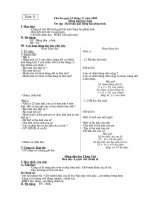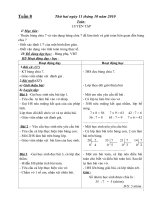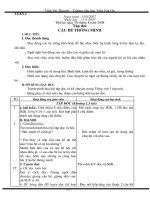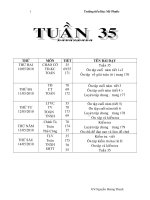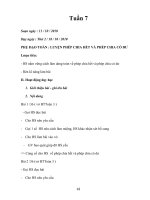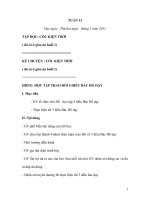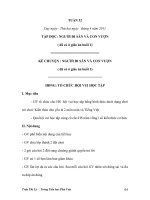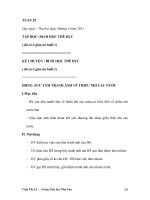GIÁO ÁN 12-HKII-(HỆ 3 NĂM)
Bạn đang xem bản rút gọn của tài liệu. Xem và tải ngay bản đầy đủ của tài liệu tại đây (207.08 KB, 34 trang )
GI¸O ¸N 12
Period allocation:52-54
Date:
REVISION
A. AIMS:
*Language teaching:
_ Gerund, Infinitive
_ Prepositions following after adjectives
_ Verbs forms.
*Skills: Writing
B. METHODS: Communicative
C. TEACHING AIDS: Blackboard, flashcards and test.
D. PROCEDUCES:
I.ORGANIZATION: Who is absent ?
II. CONTROL: Check up (no)
III. NEW CONTENTS:
STAGES
&TIME
CONTENTS TEACHER & STUDENTS’
ACTIVITIES
10 min
10 min
5 min
15 min
I. VERBS FORMS:
1. By the time Sally got back, Chris (go).
2. The police got to Claire’s house as fast as they could,
but the burglars (disappear)
3. Do (stop) (talk). I am trying (finish) the report.
4. Please go on (write). I don’t mind (wait).
5. While The Browns (have) dinner, Tom came.
II. WORD FORMS:
1. It is more (convenient) to drive your car on the right.
2. Vietnam is a (agriculture) country.
3.You’re very (fool) to give up job while you’re in need of
money.
4. Reading can (enrich) our mind.
5. The (polute) in this area makes the tourists terrified.
III. PREPOSITIONS:
1.David was ashamed ________ what he had done.
2. I’m keen_______ the idea of going climbing.
3. It’s very good ________ you to help me.
4. All the players are always confident_____ victory.
5. I am interested _________ reading scientific books.
IV. WRITING:
1. I first met you at Juron Park.
→Juron Park .......................................................
2. Shakespeare was born in Stratford-On-Avon.
→Stratford-On-Avon .............................................
3. Graham found the film very boring.
→Graham was ......................................................
_ T. asks Sts some questions
about tenses ( simple present,
present perfect, simple past
and past perfect.)
_ Sts answer and do the
excercises.
_ T. asks Sts some questions
about the positions of some
words in the sentence.
_Sts answer and give the
correct forms of the words in
the brackets.
_ Sts review prepositions
following adjectives. Then
they fill in the blanks with
some prepositions.
_T. corrects.
_ T. asks Sts about Relative
Clauses:
_ Relative pronouns
_ Relative adverbs
_ Sts writing some sentences
beginning with the words
provided.
_ T. corrects
1
GI¸O ¸N 12
4. John finds rather difficult to drive on the right in
Vietnam.
→John is used .....................................................................
5. His friend failed the final test.
→His friend wasn’t successful ................................
IV. CONSOLIDATION:
_ Prepositions following adjectives.
_ Gerund, Infinitive and word forms.
_ Writing by using relative clauses
V. HOMEWORK:
_ Prepare Unit 7: Reading
VI. SELF-EVALUATION:
_ Students understand the lesson and can do the excercises without too much difficulty.
_ Students are confused about prepositions following some adjectives.
-------------------------------------------------------*****---------------------------------------------------------------
Period allocation:55-56
Date:
Unit 7: BEING A WELCOME GUEST
A. AIMS:
*Language teaching:
- Greeting and starting conversation in American life
- American culture through the reading
*Skills: Training reading and speaking skills.
B. METHODS: Communicative
C. TEACHING AIDS: Book, pictures, the b/b and flashcards
D. PROCEDUCES:
I.ORGANIZATION: Who is absent ?
II. CONTROL: Check up (no)
III. NEW CONTENTS:
STAGES
&TIME
CONTENTS TEACHER & STUDENTS’
ACTIVITIES
I.WarmUp
5 min.
II . PRESEN
TATION :
1. Do you invite guests to your house ? If so, how
often ?
2. Do you greet your guests by shaking hands ?
3. Do you help your guests take off their coat ?
4. How do you say goodbye?
5. If you don’t invite guests yourself, talk about your
parents’ guests.
*VOCABULARY:
_T. asks Sts some questions
about greeting guests
inVietnam ?
_ Sts answer and then T.
introduces the new lesson.
_ T. gives Sts some key words
2
GI¸O ¸N 12
10 min.
III.
Practice
25 min.
_ Guest /gest/ n
_ Associate / / n
_ Host / / Hostess / / n
_ Welcome /welk m/ Adj
_ Formal /’f ml/ adj
_ Militant /’milit nt/ adj
_ Make a point of (exp): Coi lµ cÇn thiÕt
_ Shake hands (v): B¾t tay
_ Be used to + v_ing (v) : Quen víi...
*Par. 1:
1. American men shake hands when.................................
2. They don’t shake hands when.......................................
3. When a woman and a man are introduced, shaking
hands is up to___________.
a. a man b. a woman c. both of them
*Par.2:
1. American women are used to :
a. __________________
b. __________________
c. __________________
d. __________________
2. American women may start conversations with men
or even ask them to dance. (T/F).
*Par 3:
_ The attitude of nonsmokers in public places is
________
*Par 4 :
_ You should always bring gifts when visiting your
friends. (T/F)
and some phrases or
expressions that cause
difficult for Sts to understand
the reading.
_ Sts copy in their notebooks
and making their own
sentences with those words.
_ T. corrects
_ T. prepares some flashcards
and sticks on the b/b.
_ T. asks Sts to do the tasks
on the b/b.
_ T. corrects.
* Suggested answers:
a. independent
b. going places by themselves
c. earning their own money
d. living alone.
_ T. asks Sts to indicate the
line to which the sentence
belong.
_ T. asks : “How do you know
?”
IV. CONSOLIDATION:
_ Some vocabulary and phrases Sts should remember.
_ The main ideas of the reading.
_ Some greeting expressions in daily life.
V. HOMEWORK:
_ Learning the contents of the reading and prepare the Comprehension.
VI. SELF-EVALUATION: Sts are good at reading and understanding the reading.
-------------------------------------------------------******--------------------------------------------------------------
3
GI¸O ¸N 12
Period allocation: 57-58
Date:
Unit 7: COMPREHENSION
A. AIMS:
*Language teaching:
_ True / False sentences
_ Practising asking and answering the questions
*Skills: Writing and speaking
B. METHODS: Communicative
C. TEACHING AIDS: Book, the b/b and flashcards
D. PROCEDUCES:
I.ORGANIZATION: Who is absent ?
II. CONTROL: Check up
1. What are American women used to?
2. What should you do before you light up a cigarret ?
III. NEW CONTENTS:
STAGES
&TIME
CONTENTS TEACHER & STUDENTS’
ACTIVITIES
I. LEAD
IN:
10 min.
10 min.
20 min.
1. Americans tend to be ________ in get-togethers.
2. When Americans meet, they usually __________.
3. Shaking hands is up to ________________.
4. _________ American women live alone.
5. American may ask men to __________________.
6. Many restaurants have special sections for _________.
*TRUE - FALSE:
a.T b. F c.F d.F
e.T f.F g.F h.F
* Ask and answer the following questions:
a. They shake hands when they meet. They don’t when
they say goodbye.
b. They are used to being independent, going places by
themselves, earning their own money and living alone.
c. A man usually asks his partner to dance.
d. No, they don’t.
e. I should ask the host or the hostess before I light up a
cigarette.
f. It is militant.
_T. asks Sts to fill in the
blanks with the words in the
text. ( T. sticks some sentences
on the b/b ).
* Suggested answers:
1.informal
2. shake hands
3. the woman
4. most > < few
5. dance
6. smokers
_ Sts say TRUE / FALSE
according to some sentences
T. sticks on the b/b.
_ T. asks Sts to look through
the text again and answer the
questions in the book.
_ Sts go to the b/b and write
down their answers on the b/b.
_ T. corrects.
IV. CONSOLIDATION:
_ The main contents of the reading.
_ Some expressions in the reading.
4
GI¸O ¸N 12
V. HOMEWORK:
_ Summarize the reading in your own words.
_ Write a passage about 100 words about greeting and closing a conversation in Vietnam.
_ Preparing Practice.
VI. SELF-EVALUATION:
_ Sts understand the reading and do the test very well.
_ Sts read without stress or intonation.
-------------------------------------------------------******--------------------------------------------------------------
Period allocation:59-60
Date:
Unit7: PRACTICE
A. AIMS:
*Language teaching:
- Pronunciation practice.
- Compare: Use, used to, be usedto
- Expressions of greetings and goodbye.
*Skills: Writing and speaking
B. METHODS: Communicative
C. TEACHING AIDS: book and pictures
D. PROCEDUCES:
I.ORGANIZATION: Who is absent ?
II. CONTROL: Check up
1. What is the main idea of the reading ?
2. Summarize the reading .
III. NEW CONTENTS:
STAGES
&TIME
CONTENTS TEACHER’S &
STUDENTS’ ACTIVITIES
I.PRESEN
TATION:
10 Min.
II. PRAC
-TICE.
I. PRONUNCIATION PRACTICE:
*Notes: In the following words, there is one stressed
syllable which receives its full vowel sound, and one or
more non-stressed syllables having a vowel pronounced /
∂ / :
- company - introduce
- together - woman
-other - protect
II. REVIEW OF BE USED TO:
* Notes:
- BE USED TO: Quen lµm g× , víi viÖc g×.
- BE USED TO + V_ing / N : Thêng dïng ®Ó diÓn t¶ mét
thãi quen, mét sù quen thuéc.
EX: 1. You’ll be used to this kind of work.
2. American are used to going places by themselves.
- T. writes some words on the
b/b and asks Sts to read out
loudly , and then T. asks Sts
to indicate the vowel
pronouced /∂ /.
- Sts practice and find other
words in the reading that
following the same pattern.
- T gives examples 1 and 2
and asks Sts to translate into
Vietnamese.
- T. elicits the meaning of BE
USED TO.
- T. guides Sts to compare
with USED TO.
5
GIáO áN 12
15 Min.
10 Min.
*Compare with USED TO:
- USED TO + V_inf = WOULD + V_inf : thờng dùng để
diển tả một hành động thờng diển ra trong quá khứ.
EX: I used to go to school alone.
III. GREETING & SAYING GOODBYE EXPRESSIONS:
*Some expressions are normally used in greeting : ( Sts
see in the book page 104 and 105)
*Some expressions are normally used in saying goodbye:
(Sts see in the book page 105 and 106.)
- Practice greeting and responses in the following
expressions. (sent. a e )
- Practice saying goodbye in these situations.
( sent. a d. )
- T. asks Sts to give some
examples about USED TO.
- T. asks Sts to look at the
book and practice the
greeting and saying goodbye
expressions in pairs
- Sts practice.
- T. corrects.
IV. CONSOLIDATION:
- Stressed syllables and non-stressed syllables.
- Compare USED TO / BE USED TO.
- Expressions of greeting and saying goodbye.
V. HOMEWORK:
1. He doesnt have long hair any more.
He used .......................................................
2. Tom finds rather difficult to drive on the right in Vietnam.
Tom is used ...........................................................................
VI. SELF-EVALUATION:
- Sts are rather weak at pronouncing words.
-------------------------------------------------------*****---------------------------------------------------------------
Period allocation: 61
Date:
Unit7: WORD STUDY
A. AIMS:
*Language teaching:
- British and American English.
- Spelling .
*Skills: Speaking
B. METHODS: Communicative.
C. TEACHING AIDS: Book and the b/b
D. PROCEDUCES:
I.ORGANIZATION: Who is absent ?
II. CONTROL: Check up
1. Hoa used to..................................................
2. My mother is used to .................................................
3. What will you say if you want to leave your teachers house?
4. What would you say when your teacher comes to class?
6
GI¸O ¸N 12
III. NEW CONTENTS:
STAGES
&TIME
CONTENTS TEACHER & STUDENTS’
ACTIVITIES
I.PRESE
NTATIO
N
15 Min
II.PRAC-
TICE
15 Min
BRITISH AND AMERICAN ENGLISH
These two varieties of English have both changed a
great deal in he last three hundred year or so, and
naturally, they haven’t developed I exactly in the same
way. however, the differences between them are very not
great, Most British and American speakers can understand
each other quite easily ( though pronunciation can cause a
few problem) and the written language is very similar
indeed in the two countries . Here are some differences in
vocabulary. Notice that some different words are used for
the same idea.
EX: Apartment (US) >< Flat ( Great Britain)
or the same words has different meanings.
EX: Mad : - Angry (US ) >< Crazy ( Great Britain )
American English British English
automobile ( motor) car
bar pub
cab taxi
can tin
candy sweet
closet cupboard
drug store chemist’s
movie ... film
- T. gives some examples
( words in British English and
American English).
-T. asks Sts about their
meanings. Then T. explains
how they are different.
- T. asks Sts to write down
some notes and gives some
more examples.
- Sts practice by finding the
meanings of those words and
then pronounce them in the
correct way.
- Sts must notice their spelling
of those words.
- T corrects Sts’ task.
IV. CONSOLIDATION:
* The differences in British English and American English:
- Different words are used for the same idea.
- spellings
V. HOMEWORK:
- Find five words which have the same way.
- Find five words of spellings.
VI. SELF-EVALUATION:
------------------------------------------------------------*****---------------------------------------------------
Period allocation: 62
Date:
Unit 7: FURTHER PRACTICE
A. AIMS:
*Language teaching:
- Greeting and closing a conversation.
- Speaking in pairs.
*Skills: Speaking.
B. METHODS: Communicative
7
GI¸O ¸N 12
C. TEACHING AIDS: Book, the b/b and some flashcards.
D. PROCEDUCES:
I.ORGANIZATION: Who is absent ?
II. CONTROL: Check up
1. Write five words on the b/b and say out the differences in those words.
2. Write five words on the b/b and spelling them.
III. NEW CONTENTS:
STAGES
&TIME
CONTENTS TEACHER &
STUDENTS’ ACTIVITIES
I.
WARM-
UP
15 Min
II. PRAC
TICE
20 Min
* Review of greeting and closing expressions:
1. Greeting expressions:
- Good ........ How are you ?
- How are you tonight ?
- Hello. ....... How are you doing ?
- Hi. What are you doing these days ?
- Morning, ....... Are you doing okey ?
+ Responses:
- I’m doing very well, thank you and you ?
- Fine, and you ?
- Great, thanks. What about you?
- Not bad. You ?
2. Closing expressions:
- Look at the time ! I’ve really got to go! Goodnight.
- Have a good day.
- Take care.
- See you next week.
- So long.
- Bye!
3. Practice the conservation page 109 and 110:
Michael invites his friends to his flat. Complete the
conversation. Practice in pairs.
- T. asks Sts some of the
expressions which are used
in greeting and closing a
conservation.
- Sts list and T. write down
on the b/b
- Sts practise again these
expressions by speaking in
pairs.
- T. corrects
- Sts fill in the blanks with
correct words and phrases
and then practise in pairs
IV. CONSOLIDATION:
- Some expressions of greeting and closing
- Practise in pairs the conservation
V. HOMEWORK:
- Learn the conservation by heart to practise with your classmates
- Prepare Test
VI. SELF-EVALUATION:
- T. must take notice of Sts’ pronouncing and speaking in pairs.
-------------------------------------------------------******--------------------------------------------------------
Period allocation: 63
Date:
8
GI¸O ¸N 12
Unit 7: TEST
A. AIMS:
*Language teaching:
- Vocabulary of the reading 7.
- Review : Used to, Be used to
*Skills: Writing and speaking
B. METHODS: Communicative
C. TEACHING AIDS: Book, flashcards and the extra board.
D. PROCEDUCES:
I.ORGANIZATION: Who is absent ?
II. CONTROL: Check up
1. Sts practise the conversation.
III. NEW CONTENTS:
STAGES
&TIME
CONTENTS TEACHER & STUDENTS’
ACTIVITIES
I.
REVIEW
15 Min
*
REVIEW
II. PRAC
TICE
10 Min
I. Gap - filling:
Company Shake
Business associates Say hello
Expected Smokers
Get-togethers Gesture
Say goodbye Public
II. Review USE, USED TO + Infinitive, or BE USED TO
- Use (v) : Dïng, sö dông
EX: You can use this dictionary to look up some new words.
- Used to + inf : Thêng = Would + inf : DiÔn ®¹t mét thãi
quen trong qu¸ khø.
EX: He used to play truant when he was six.
- Be used to + v-ing = Be accustomed to = Get used to +V-
ing : Quen víi, trë nªn quen víi.
EX: I am used to living in this kind of weather.
* Keys to the exercises:
a. don’t use
b. used to
c. am used to
d. used to
e. use
f. are used to
g. used to
h. is used to
i. use
- T. asks Sts to look back the
reading again and listen to
some T.’s questions
- T. asks Sts some questions
to elicit these words
- T. write these words on the
b/b and asks Sts to fill in the
blanks with these words
- T. asks Sts how to use :
USE/ USED TO / BE USED
TO
- Sts gives examples
- T. summarizes on the b/b
- Sts practise by fill in the
blanks with USE, USED TO
and BE USED TO
- T. corrects
IV. CONSOLIDATION:
- Some key words of the text.
- Review USE, USED TO, BE USED TO.
V. HOMEWORK:
9
GI¸O ¸N 12
* Learn the lesson and complete the following sentences:
1. I used to............................................................
2. My mother is used to........................................
3. There __________ (be) a shop near my house.
VI. SELF-EVALUATION:
- Sts understand the lessons and do the exercises very well.
-------------------------------------------------------*****---------------------------------------------------------------
Period allocation: 64
Date:
10
GI¸O ¸N 12
45 - minute TEST
A. AIMS:
*Language checking:
- Expressions of greeting and closing
- Use, used to and be used to.
*Skills: Writing
B. METHODS: Writing test
C. TEACHING AIDS:
D. PROCEDUCES:
I.ORGANIZATION: Who is absent ?
II. CONTROL: Check up (no)
III. NEW CONTENTS:
STAGES
&TIME
CONTENTS TEACHER & STUDENTS’
ACTIVITIES
IV. CONSOLIDATION: (no)
V. HOMEWORK: (no)
VI. SELF-EVALUATION:
___________________________________*******_________________________________________
Period allocation: 65 - 68
Date:
Unit 8: THE SWORD THAT CAN HEAL
11
GIáO áN 12
A. AIMS:
*Language teaching:
- The uses being made of the laser
- The advantages of the laser in treating some diseases
*Skills: Reading comprehension
B. METHODS: Communicative
C. TEACHING AIDS: book, pictures and the extra board.
D. PROCEDUCES:
I.ORGANIZATION: Who is absent ?
II. CONTROL: Check up (no)
III. NEW CONTENTS:
STAGES
&TIME
CONTENTS TEACHER & STUDENTS
ACTIVITIES
I.
WARM-
UP
5 Min
II.
PRESEN
TATION
15 Min
A. Preliminary activities
1. Do you know anything about the laser?
2. Have you ever been treated by the laser ?
3. what do you know about the advantages of the laser ?
B. VOCABULARY
(n) - abnormality : dị tật
- beam : tia sáng
- birthmark : vết chàm, bớt
- bone : xơng
- deafness : bệnh điếc
- deficiency : sự suy giảm
- eardrum : màng nhĩ
- intensity : độ mạnh
- laser : tia la-ze
- nerve : dây thần kinh
- scalpel : dao mổ
- tissue : mô
- ulcer : vết lở, loét, ung th
- vessel : thành, mạch máu
(a) - accessible : có thể tới đợc
- conspicuous : dễ nhìn thấy
- conventional : thông thờng
- comestic : thẩm mỹ
- delicate : mỏng manh
- military : quân đội
- peptic : ( thuộc về ) tiêu hoá
- untreatable : không thể điều trị
(v) - absorb : hấp thụ
- attach : gắn chặt
- conceal : che, dấu
- inject : tiêm, chích
- solidify : đông cứng
- spot : định vị
- vaporise : bốc hơi, làm tiêu
- T. asks Sts some questions
about the laser
- Sts answer
- T. introduces the lesson
- T. supplies some new words
in the reading.
- T. reads the new words
- Sts repeat
- T. corrects the Sts
pronunciation
- T. asks Sts to make the
sentences with these words
- Sts speak out
- T. corrects
- T. asks Sts to read the
reading quietly and try to
understand the contents of the
reading and do the exercises
that T. prepared on the extra
board.
- Sts practise
* Suggested answers:
1. The general theme of the
passage:
12
GI¸O ¸N 12
III.
PRAC-
TICE
15 Min
*
PRESEN
TATION
10 Min
10 Min
* PRAC-
TICE
20 Min
C. Contents .
1. Which of the headings below describes the general
theme of the passage.
- Military uses for the laser
- Cancer surgery
- Surgical uses for the laser
- New technology in British hospitals
2. Match the following headings to the paragraphs
a. Treating cancer
b. Ear surgery
c. Cosmetic surgery
d. The laser as a powerful surgical treatment
e. The laser in British hospitals.
D. COMPREHENSION
1. ACRONYMS
EX: LASER = Light amplication by stimulated emission
of radiation.
* Such words are called acronyms, which are made up of
initial letters of phrases and pronounced as letters / el ei es
i a/ but rather serve simply as letters in new words
pronouced as a whole. Acronyms are often used without
knowing what the letter stands for.
* Practice: Match these acronyms with their sources
(p.118)
2. GATHERING MAIN IDEAS
Complete the chart:
What the laser is used to treat
How it is used
Advantages of using the laser
1. Cancer
destroys diseased cells
leaves healthy cells unharmed
2. Deafness
removes bone
does not touch any surrounding tissue
3. Birthmarks
- para A
- para B
- para C
- para E
2. The headings:
- B
- C
- D
- A
- E
- T. gives an example of the
acronym and asks Sts how it
is formed
- Sts answer
- T. remarks
- Sts practice
- T. asks Sts to read the
reading again and fill in the
chart with the correct
information from the reading
- Sts do the task according to
the guidance of the teacher
- T. corrects
- Sts copy into their book
13

